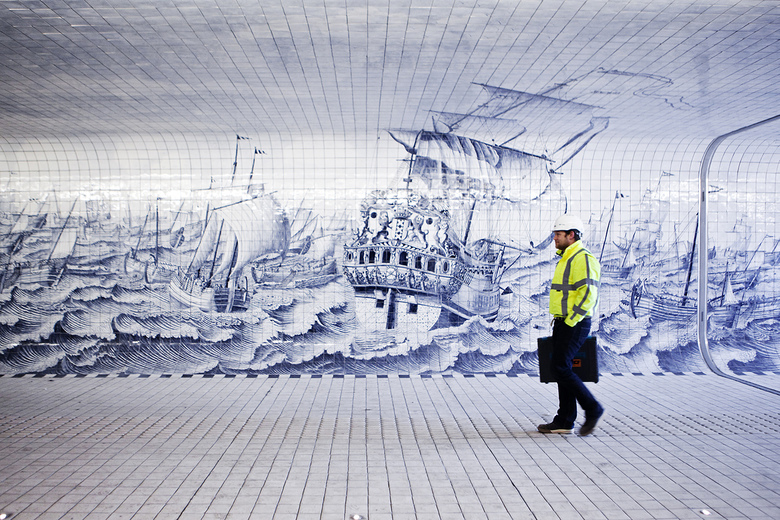Thousands of Blue Tiles Line an Amsterdam Tunnel
Benthem Crouwel Architects, working with designer Irma Boom, have created a cycling and pedestrian "slow traffic corridor" at Amsterdam's Central Station that is clad on one side by nearly 80,000 Delft Blue tiles.
Cuyperspassage, as the 110-meter-long tunnel is known, connects the city south of the station to the waters of the IJ-river to the north. As the section below illustrates, the tunnel runs perpendicular and beneath the tracks and railway platforms of Amsterdam Central Station, where Benthem Crouwel Architects has led a master plan since 1996. In addition to the Cuyperspassage that opened in November 2015, last year they also completed the Ij Passage and a Bus Drivers Building at the station.
The 10-meter-wide tunnel is split into two halves following the two types of movement: bicycle lanes on one side and a slightly raised walkway on the other. Both have the same curved profile, but the former has an asphalt surface with wall and ceiling of steel grating, while the latter features the Delft Blue tiles that wrap from floor to ceiling.
In designing the tile tableau, Irma Boom started from a restored 18th-century work by the Rotterdam tile painter Cornelis Boumeester, a panel depicting the Warship Rotterdam and the Herring Fleet from the collection of the Rijksmuseum. According to the architects, "Boom replaced the original crest on the stern with the Amsterdam coat of arms. The cyclist or pedestrian leaves the old historic part of Amsterdam through Cuyperspassage and heads towards 'new Amsterdam' in the north, or vice versa."
The narrative tableau is dense toward the south, city end of the Cuyperspassage, but it fades away toward the river on the north; here, "it builds up again in an abstract form from light to dark blue, as if encouraging cyclists to slow down as the ferry comes into view," per the architects.
Manufacturing, painting and glazing of the nearly 80,000 tiles – 46,000 wall tiles for the tableau and 33,000 floor tiles – were carried out by Royal Tichelaar Makkum, a company whose origins date back to the 16th century. Given their history, the Dutch ceramic company was the logical choice for making the handmade, traditional 13 x 13 cm tiles, even more so because they carried out the restoration work of the tile piece Boom based the tableau on. But as the Cuyperspassage and the egg-shaped Museum de Fundatie in Zwolle we featured previously shows, Royal Tichelaar Makkum is capable of carrying out contemporary designs.
Royal Tichelaar Makkum shaped and painted the nearly 80,000 tiles by hand "in the traditional Old Holland format of 130 x 130 mm, which has been made at [their] factory for more than three centuries," per their website. In lieu of the sea clay they would normally use, here they replaced it with a "bought-in clay fired at a higher temperature in order to create a frost-resistant and wear-resistant product." The result is an "urban room," as the architects liken it, that is visually striking but also highly durable, able to hold up to thousands of pedestrians every day.








